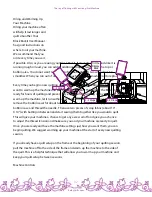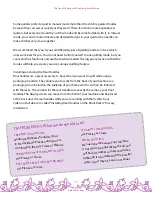
The Joy of Quilting with Your Long-Arm Machine
46
KathyQuilts.com
any design and can move in all directions, but as a general rule, quilting from left to
right will help your machine and quilting run more smoothly.
Securing your stitches
In order for your quilting stitches to be securely locked into your quilt as you begin a
new stitch, the bobbin thread needs to be brought up from the bottom of the quilt and
sewn over and anchored. (Think of this process as your “back stitching” on a normal
home sewing machine)
1- Move machine where you want to to start quilting.
Press needle up/down button to lower your needle
while holding the top thread in your other hand.
2- Bring the needle back up and move the machine
about an inch or two to the side. The bobbin thread
will come up through the hole you just made.
3- Hold both the top and bobbin thread in one hand
and move the machine back to the hole. You will
begin stitching at this hole. Turn the machine on, and
take a couple of stitches. Turn the machine off, trim
both threads you were holding, and then continue
quilting. Your threads have been anchored.
Every time you stop quilting and cut your thread,
follow these steps to start quilting again so that your
stitches will be anchored into your quilt.
Practice Free Motion quilting
If you are new to quilting, practice free-motion quilting before any other type of
quilting to become familiar with the machine and its movement. Free-motion quilting
is moving the machine without following a pre-drawn pattern, and it is the fastest and
most effective way to gain confidence in using your machine and knowing how it feels.
It is vital to have smooth and consistent motions while quilting, and free motion quilting
can help you learn to do this. Even if you plan on following pantograph patterns with
HELPFUL VIDEO:
Securing your stitches
















































